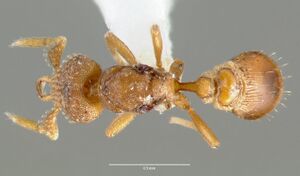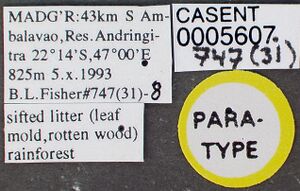Strumigenys mola
| Strumigenys mola | |
|---|---|

| |
| Scientific classification | |
| Kingdom: | Animalia |
| Phylum: | Arthropoda |
| Class: | Insecta |
| Order: | Hymenoptera |
| Family: | Formicidae |
| Subfamily: | Myrmicinae |
| Tribe: | Attini |
| Genus: | Strumigenys |
| Species: | S. mola |
| Binomial name | |
| Strumigenys mola Fisher, 2000 | |
A rainforest species, little is known about the biology of S. mola.
Identification
Bolton (2000) - A member of the abdera complex in the Strumigenys arnoldi-group. Of the species known of this group which lack pronotal humeral hairs and lack spoon-shaped or scale-like hairs on the posterior third of the dorsum of the head, mola is immediately identifiable by the presence of a pair of hairs on the anterior margin of the mesonotum.
Keys including this Species
Distribution
Latitudinal Distribution Pattern
Latitudinal Range: -22.23333° to -22.23333°.
| North Temperate |
North Subtropical |
Tropical | South Subtropical |
South Temperate |
- Source: AntMaps
Distribution based on Regional Taxon Lists
Malagasy Region: Madagascar (type locality).
Distribution based on AntMaps
Distribution based on AntWeb specimens
Check data from AntWeb
Countries Occupied
| Number of countries occupied by this species based on AntWiki Regional Taxon Lists. In general, fewer countries occupied indicates a narrower range, while more countries indicates a more widespread species. |

|
Estimated Abundance
| Relative abundance based on number of AntMaps records per species (this species within the purple bar). Fewer records (to the left) indicates a less abundant/encountered species while more records (to the right) indicates more abundant/encountered species. |

|
Biology
|
Castes
Worker
Images from AntWeb
   
| |
| Holotype of Strumigenys mola. Worker. Specimen code casent0005608. Photographer April Nobile, uploaded by California Academy of Sciences. | Owned by MCZ, Cambridge, MA, USA. |
Queen
Images from AntWeb
   
| |
| Paratype of Strumigenys mola. Queen (alate/dealate). Specimen code casent0005606. Photographer April Nobile, uploaded by California Academy of Sciences. | Owned by CAS, San Francisco, CA, USA. |
  
| |
| Paratype of Strumigenys mola. Queen (alate/dealate). Specimen code casent0005607. Photographer April Nobile, uploaded by California Academy of Sciences. | Owned by CAS, San Francisco, CA, USA. |
Nomenclature
The following information is derived from Barry Bolton's Online Catalogue of the Ants of the World.
- mola. Strumigenys mola Fisher, in Bolton, 2000: 635 (w.q.) MADAGASCAR.
Unless otherwise noted the text for the remainder of this section is reported from the publication that includes the original description.
Description
Worker
Holotype. TL 1.9, HL 0.44, HW 0.41, CI 91, ML 0.16, MI 36, SL 0.23, SI 56, PW 0.25, AL 0.52. Characters of abdera-complex. Right mandible with a long proximal and a small distal preapical tooth; left mandible with a long proximal preapical tooth and a distal preapical denticle. Cephalic dorsum posterior of clypeal margin with spoon-shaped hairs on anterior two thirds; upper scrobe margin with spoon-shaped hairs. Posterior margin of vertex with a row of 4 erect, narrowly clavate hairs. Pronotal humeral hair absent; anterior margin of mesonotum with a pair of short standing hairs. In profile, promesonotum shallowly convex; metanotal groove a shallow concave depressi on. Propodeal dorsum convex anteriorly, sloping posteriorly to the declivity and posteriorly rounding into the sides. Propodeal dorsum meeting the declivity in a blunt angle without a noticeable tooth. In profile, spongiform lamella on propodeal declivity narrow, increasing in width at base of declivity. Ventral spongiform tissue well developed and conspicuous on petiole and postpetiole. Ventral lobe on petiole small. Base of first gastral tergite with a continuous row of well defined basal costulae, remainder of gaster smooth and shiny. Pilosity of postpetiole and gaster filiform to narrowly clavate. Color dull yellow to pale brown.
Paratypes. TL 1.7-1.9, HL 0.41-0.44, HW 0.38-0.40, CI 90-96, ML 0.15-0.16, MI 35-40, SL 0.19-0.24, SI 48-60, PW 0.23-0.25, AL 0.42-0.47 (6 measured). As holotype.
Type Material
Holotype worker, Madagascar: 43 km. S Ambalavao, Res. Andringitra 22°14'S, 47°00'E, 825 m., 5.x.1993, sifted litter (leaf mold, rotten wood), rainforest #747 (7)-7 (B. L. Fisher) (Museum of Comparative Zoology).
Paratypes. 6 worker and 2 queens (deal ate) with same data as holotype but coded (2)-11, (8)-12, (19)-12, (31)-8, (26)-12, (42)-15, (43)-11 (The Natural History Museum, South African Museum).
References
- Fisher, B.L. 2000. The Malagasy fauna of Strumigenys. Pp. 612-696 in: Bolton, B. 2000. The ant tribe Dacetini. Memoirs of the American Entomological Institute. 65:1-1028. (page 635, worker described)
References based on Global Ant Biodiversity Informatics
- Bolton, B. 2000. The Ant Tribe Dacetini. Memoirs of the American Entomological Institute 65
- Fisher B. L. 2003. Formicidae, ants. Pp. 811-819 in: Goodman, S. M.; Benstead, J. P. (eds.) 2003. The natural history of Madagascar. Chicago: University of Chicago Press, xxi + 1709 pp.

